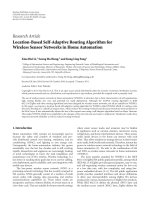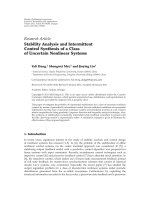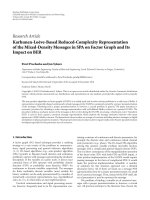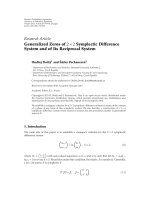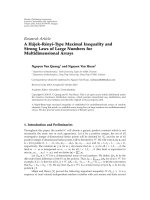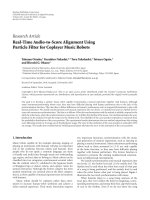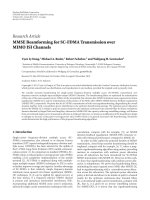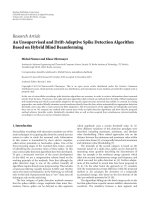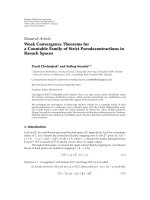Báo cáo hóa học: " Research Article Average Throughput with Linear Network Coding over Finite Fields: The Combination Network Case" doc
Bạn đang xem bản rút gọn của tài liệu. Xem và tải ngay bản đầy đủ của tài liệu tại đây (621.53 KB, 7 trang )
Hindawi Publishing Corporation
EURASIP Journal on Wireless Communications and Networking
Volume 2008, Article ID 329727, 7 pages
doi:10.1155/2008/329727
Research Article
Average Throughput with Linear Network Coding over
Finite Fields: The Combination Network Case
Ali Al-Bashabsheh and Abbas Yongacoglu
School of Information Technology and Enginee ring, University of Ottawa, Ottawa, Canada K1N 6N5
Correspondence should be addressed to Ali Al-Bashabsheh,
Received 4 November 2007; Revised 17 March 2008; Accepted 27 March 2008
Recommended by Andrej Stefanov
We characterize the average linear network coding throughput, T
avg
c
, for the combination network with min-cut 2 over an arbitrary
finite field. We also provide a network code, completely specified by the field size, achieving T
avg
c
for the combination network.
Copyright © 2008 A. Al-Bashabsheh and A. Yongacoglu. This is an open access article distributed under the Creative Commons
Attribution License, which permits unrestricted use, distribution, and reproduction in any medium, provided the original work is
properly cited.
1. INTRODUCTION
For a set of sinks in a directed multicast network, it was
shown in [1] that if the network can achieve a certain
throughput to each sink individually, then it can achieve
the same throughput to all sinks simultaneously by allowing
coding at intermediate nodes. Such argument is possible
since information is an abstract entity rather than a physical
one. Thus, in addition to repetition and forwarding, nodes
can manipulate the symbols available from their in-edges
and apply functions of such symbols to their out-edges. The
collection of edge functions can be referred to as the network
code. The work in [1] shows that a natural bound on the
achievable coding rate is the least of the min-cuts between
the source and each of the sinks. We refer to a code achieving
the min-cut rate as a solution.
It is known that every multicast network has a linear
solution over a sufficiently large finite field [2]. Sanders et al.
[3] showed for linear network coding that an alphabet of size
O(
|T |)issufficient to achieve the min-cut rate, where |T |
is the number of sinks in the network. Rasala-Lehman and
Lehman [4] indicated that such bound is tight by advising
a solvable multicast network requiring an alphabet of size
Ω(
|T |) to achieve the min-cut rate. This shows that some
multicast networks might require alphabets of huge sizes
to achieve their min-cut throughputs. Coding over large
alphabet sizes is not always desirable since it introduces
some complexity and latency concerns. Hence, this motivates
working below min-cut rates (i.e., relaxing the constraint of
operating at network capacity) but with significantly smaller
alphabet sizes (if possible) [5].
Chekuri et al. [6] introduced the measure average
routing throughput by relaxing the constraint that all sinks
must receive the same rate. By decoupling the problem of
maximizing the average rate from the problem of balancing
rates toward sinks, they showed that average routing rates
can significantly exceed the maximum achievable common
routing rates in the network. They also argued that the
majority rather than the minority of multicast applications
experience different rates at the receivers. In [7], the concept
average linear network coding throughput was introduced
under the constraint where source alphabet and linear
network coding are restricted to the binary field. In this work,
we extend average coding throughput measure to include
linear coding over arbitrary finite fields. Such extension is
an important step toward practical network coding. To see
this, we first remark that in [7] the motivation to restrict
the alphabet to the binary field was to present a simple
coding scheme where nodes are not required to perform
operations over a field larger than
F
2
. Such cut on processing
complexity came with the price of reducing the total network
throughput. In practice, although nodes might not posses
the capability to perform operations over the necessary field
to achieve the min-cut throughput, they might still have
a computation capability beyond the binary field. In such
situations, it is more reasonable to design codes compatible
with nodes computation capability and thus get closer to the
min-cut throughput.
2 EURASIP Journal on Wireless Communications and Networking
In the literature, two different variations of the problem
of nonuniform coding throughputs at the terminals were
considered. The general connection model [5, 8]considers
the problem where each sink specifies its set of demanded
messages. On the other hand, the nonuniform demand
problem refers to the problem where each sink specifies only
the size of its demand (i.e., the number of messages) and such
demanded size might vary from sink to another [9]. In this
work, a sink does not specify neither the identities nor the
number of demanded messages. The objective is to maximize
the average throughput achievable with linear network
coding under the additional constraint where messages and
network coding are restricted to the finite field
F
q
(where
F
q
might not be sufficiently large to achieve the min-cut
throughput).
2. DEFINITIONS AND PROBLEM FORMUL ATION
In general, assume an h unit rate information source consists
of h unit rate messages x
1
, x
2
, , x
h
, where messages are
symbols from a finite field
F
q
. Also assume symbols carried
by edges belong to the same field
F
q
. For the comparison
between average throughputs and common throughputs to
be fair and meaningful, it is important that the number of
messages h at the source does not exceed the min-cut. In the
more general case where the min-cuts from the source to the
sinks are not equal, h canbesetsuchthatitdoesnotexceed
the smallest of such min-cuts.
A directed network N on V nodes and E links can be
modeledasadirectedgraphG(V,E). In multicast networks,
anodes
∈ V broadcasts a set of messages x
1
, , x
h
to
a set of sinks T
={t
1
, , t
n
}⊆V \ s where h is the
smallest min-cut between s and t,forallt
∈ T .Foranyedge
e
∈ E,wedenotebyδ
in
(e) the set of edges entering the node
from which e departs. At some parts of this work, we find it
more convenient to deal with the valuation (defined below)
induced by the network code rather than the network code
itself.
Definition 1. Givenanetworkcode,C,definedbyacollec-
tion of functions f
e
,foralle ∈ E such that
f
e
: F
|δ
in
(e)|
q
−→ F
q
. (1)
The code valuation induced by C is a collection of functions:
f
e
: F
h
q
−→ F
q
,(2)
where f
e
is the value of f
e
as a function of x
1
, , x
h
.
For a multicast network N with a set of messages at
the source whose size does not exceed the smallest of the
min-cuts between the source and each sink. Linear network
coding over sufficiently large field allows every sink t
∈
T to recover the entire set of messages. In this work, we
somehow reverse the story, that is, we restrict the field size
and allow sinks to recover subsets of the set of messages.
Since sinks do not experience the same throughput any more,
average throughput per sink becomes a natural measure to
evaluate the performance of a given network code. Hence,
the objective is to decide on a linear network code over the
specified alphabet which maximizes the average throughput-
or equivalently the sum of throughputs experienced by all
sinks. More formally, we define the maximum average linear
coding throughput over
F
q
as
T
avg
c
=
1
|T |
max
Q∈Q
t∈T
T
t
c
(Q)
,(3)
where the maximization is over Q, the set of all possible
linear coding schemes over
F
q
,andT
t
c
(Q) is the throughput
at sink t under linear coding scheme Q
∈ Q. In contrast,
maximum average routing throughput was defined in [6]
and is repeated here for convenience:
T
avg
i
=
1
|T |
max
P∈P
t∈T
T
t
i
(P)
,(4)
where in this formulation, the maximization is over all
possible integer routing schemes, P ,andT
t
i
(P) is the integer
routing throughput at sink t under routing scheme P
∈ P .
In what follows, we restrict our attention to the family of
combination networks with N intermediate nodes and min-
cut2.Suchnetworksaresufficient to develop the ideas we
need to present in this work.
3. COMPLEXITY VERSUS ALPHABET SIZE
Consider a multicast network that requires a field
F
q
of size
q to achieve the min-cut throughput. Thus, all operations to
compute edge functions must be done over the field
F
q
.In
other words, each node in the network must have a memory
of Θ(log
2
(q)) bits to store and manipulate the received
symbols. In practice, each edge can deliver a fixed number
of bits per unit time. Hence, the assumption that edges can
deliver one symbol from
F
q
per network use implies a latency
of Θ(log
2
(q)).
4. AVERAGE THROUGHPUT OF COMBINATION
NETWORK WITH MIN-CUT 2
Consider a combination network N with min-cut 2 and
messages x
1
, x
2
∈ F
q
at the source. A combination network
with min-cut 2 consists of three layers of nodes: the source
s, a set of N intermediate nodes, and a set of (
N
2
) sinks. The
source has an out-edge to each intermediate node. Finally,
each distinct pair of intermediate nodes is connected to a
unique sink via a pair of edges directed into the sink. In this
section, we derive an expression for the maximum average
throughput of N over an arbitrary finite field
F
q
.Itisknown
that the network, N , is solvable when N
≤ q +1,whereq
is the field size. Hence, average throughput is equivalent to
the min-cut throughput in this case. On the other hand, for
q
= 2, the problem was solved in [7]. Therefore, in most of
the mathematical treatment which follows, we assume 2 <
q<N
− 1. In spite of this assumption, whenever applicable,
we use the previously obtained results for the binary field and
the fact that N is solvable for q
≥ N −1 to present the results
for any q
≥ 2.
A. Al-Bashabsheh and A. Yongacoglu 3
Definition 2. Let F be a collection of functions such that
f :
F
q
×F
q
−→ F
q
,(5)
for each f
∈ F . Then, an average throughput, T
avg
c
,issaidto
be achievable over F if there exists a network code valuation
C
={f
e
(x
1
, x
2
): f
e
(x
1
, x
2
) ∈ F for all e ∈ E} achieving
T
avg
c
.
Let G
={αx
1
+ βx
2
: α, β ∈ F
q
} be the set of all linear
functions (combinations) of x
1
and x
2
over F
q
. Also let F =
{
x
2
}∪{x
1
+ βx
2
: β ∈ F
q
}.
Lemma 1. Let f (x
1
, x
2
) = αx
1
+ βx
2
, f
(x
1
, x
2
) = α
x
1
+ β
x
2
be two functions in G with α, β, α
, β
∈ F
q
\{0} then x
1
is
recoverable from f and f
if and only if x
2
is recoverable from
f and f
(i.e., either both messages are recoverable or non of
them).
Proof. See the appendix.
Corollary 1. Let f (x
1
, x
2
) = x
1
+βx
2
, f
(x
1
, x
2
) = x
1
+β
x
2
be
two functions in F with β, β
∈ F
q
\{0} then x
1
is recoverable
from f and f
ifandonlyifx
2
is recoverable f rom f and f
.
Proof. The corollary follows from Lemma 1 and the fact that
F
⊂ G.
Lemma 2. An average throughput, T
avg
c
, is achievable over F
if and only if it is achievable over G.
Proof. See the appendix.
Remarks
(i) Lemma 2 suggests that it is sufficient to consider the set
of functions F and there is no gain in considering G.
(ii) With a slight modifications in the proofs, it is easy to
show that Lemmas 1 and 2 are still valid even if G was
the set of all affine functions of x
1
and x
2
over F
q
.
From the definition of F , we see that
|F |=q +1,and
with the aid of Corollary 1, it is straight forward to show that
any sink receiving two distinct functions from F will be able
to recover both messages. Thus, for N
≤ q + 1 the network
is solvable [10], and the average throughput is equal to the
min-cut throughput. For N>q+ 1, a simple pigeon hole
argument shows that some source edges will be carrying the
same combination of messages. Thus, a receiver with two in-
edges carrying the same function of messages will be able to
recover one or non of the messages.
The next proposition determines how functions
f (x
1
, x
2
) ∈ F must be distributed among source out-edges
in order to maximize average throughput (i.e., minimize
loss in throughput). Let m
i
be the number of source edges
carrying f
i
(x
1
, x
2
) = x
1
+ β
i
x
2
,forall1≤ i ≤ q − 1, β
i
∈
F
q
\{0}, β
i
/
=β
j
,foralli
/
= j. With such assignment of
functions to source out edges, we still have N
−
q−1
i
=1
m
i
unused source out-edges and two functions in F namely,
f (x
1
, x
2
) = x
1
and f (x
1
, x
2
) = x
2
.Letm
0
and m
0
be the
number of source edges carrying x
1
and x
2
,respectively.
Since there is no preference in recovering one message
over the other (both messages are equally important
to each destination), a maximum average throughput
achieving assignment must have N
−
q−1
i
=1
m
i
equally divided
between m
0
and m
0
, that is, m
0
=(N −
q−1
i
=1
m
i
)/2 and
m
0
=(N −
q−1
i
=1
m
i
+1)/2. Now, if a sink has both its
in-edges carrying x
1
then it can not recover x
2
,andthus
there are (
m
0
2
) sinks which cannot recover x
2
. Similarly, there
are (
m
0
2
) destinations which cannot recover x
1
. Finally, a
destination receiving f
i
(x
1
, x
2
) = x
1
+ β
i
x
2
, β
i
/
=0onboth
of its in-edges will not recover any of the messages, and so
there is a loss of 2(
m
i
2
). Hence, the total loss in throughput is
given by
L
m
1
, , m
k
=
⎛
⎜
⎝
N −
k
i=1
m
i
2
2
⎞
⎟
⎠
+
⎛
⎜
⎝
N −
k
i=1
m
i
+1
2
2
⎞
⎟
⎠
+2
k
i=1
⎛
⎝
m
i
2
⎞
⎠
,
(6)
where k
= q − 1 and the average throughput, as function of
m
1
, , m
k
,isgivenby
T
avg
c
m
1
, , m
k
=
1
(
N
2
)
2
N
2
−
L
m
1
, , m
k
. (7)
Before we present the proposition, we need the following
lemma.
Lemma 3. Let
A
=
⎛
⎜
⎜
⎜
⎜
⎜
⎜
⎜
⎝
a 1 ··· 1
1 a
··· 1
.
.
.
···
.
.
.
1
1
··· 1 a
⎞
⎟
⎟
⎟
⎟
⎟
⎟
⎟
⎠
(8)
be a k
×k matrix with a ∈ R, a
/
=1 or −(k − 1), then
A
−1
=
1
(a −1)(a + k − 1)
×
⎛
⎜
⎜
⎜
⎜
⎜
⎜
⎜
⎝
a +(k − 2) −1 ··· −1
−1 a +(k −2) ··· −1
.
.
.
···
.
.
.
.
.
.
−1 ··· −1 a +(k − 2)
⎞
⎟
⎟
⎟
⎟
⎟
⎟
⎟
⎠
.
(9)
Proof. See the appendix.
Proposition 1. Average linear network coding throughput of
network N is maximized when m
1
= m
2
=···=m
k
:= m
∗
int
,
where
(N +1)/(k +4)≤m
∗
int
≤(N +1)/(k +4) +1.
4 EURASIP Journal on Wireless Communications and Networking
Proof. From (6), we can write size
L
m
1
, , m
k
=
1
2
N−
k
i=1
m
i
−δ
2
N−
k
i=1
m
i
−δ
2
−1
+
N−
k
i
=1
m
i
+δ
2
N−
k
i
=1
m
i
+δ
2
−1
+4
k
i=1
m
i
m
i
−1
2
,
(10)
where δ
= 0and1forN −
k
i
=1
m
i
is even and odd,
respectively. This reduces to
L
m
1
, , m
k
=
1
4
N −
k
i=1
m
i
2
−2
N −
k
i=1
m
i
+4
k
i=1
m
i
m
i
−1
+ δ
.
(11)
For the moment, we relax the constraintthat m
1
, , m
k
must be integer valued. We also relax the constraint that
(N
−
k
i=1
m
i
)/2and(N −
k
i=1
m
i
+1)/2 must be integers
(notethatwithsuchrelaxationδ disappears from (11)). Now,
we compute the partial derivative of (11)withrespectto
m
j
,forall1≤ j ≤ k and equate to zero. Thus, we obtain
5m
j
+
i
/
=j
m
i
= N +1. (12)
This can equivalently be written as
m
1
m
2
···m
k
A = (N + 1)(1 1 ···1), (13)
where A
= 4I + 1, I is the k × k identity matrix, and 1 is the
all ones k
×k matrix. Thus,
m
1
m
2
···m
k
= (N + 1)(1 1 ···1)A
−1
(14)
and from Lemma 3 (using a
= 5), we obtain
m
1
m
2
··· m
k
=
N +1
k +4
(1 1
···1), (15)
that is, m
1
= m
2
= ··· = m
k
= (N +1)/(k + 4). Noting
that L(m
1
, , m
k
) is a convex function of m
1
, , m
k
then
we know that the integer value m
∗
int
of m
1
, , m
k
which
minimizes L(m
1
, , m
k
)isboundedas
N +1
k +4
≤
m
∗
int
≤
N +1
k +4
+ 1 (16)
as required.
Since T
avg
c
=max
m
1
, ,m
k
T
avg
c
(m
1
, , m
k
)andT
avg
c
(m
1
, ,
m
k
) is maximized by the choice of m
1
, , m
k
as in
Proposition 1, then T
avg
c
is totally specified by m
∗
int
.The
following proposition establishes a simple relation between
m
∗
int
and the field size q.
Proposition 2. In a combination network with N interme-
diate nodes, m
∗
int
that maximizes the average linear network
coding throughput over
F
q
is given by
m
∗
int
=
N +2+q/2
q +3
, (17)
where 2 <q<N
−1.
Proof. From (7)and(11), and by substituting m
1
= m
2
=
···=
m
k
:= m,weobtain
T
avg
c
(m)=
1
2N(N −1)
4N(N −1) −(N −km)
2
+2(N −km) −4km(m −1) −δ
,
(18)
where δ
= 0forN − km is even, and δ = 1forN − km is
odd. Since δ plays a roll in the next derivations, we will write
δ(N, m) to emphasize its dependence on N and m.From
(18), we can write
T
avg
c
(m) =
1
2N(N −1)
h(m), (19)
where
h(m)
=−
k
2
+4k
m
2
−2(N +1)km
+ N(3N
−2) −δ(N, m).
(20)
Let m
a
=(N +1)/(k +4) and m
b
= m
a
+1=(N +1)/(k +
4)
+ 1, then from Proposition 1 we know that m
∗
int
is either
m
a
or m
b
.Thus,wecanwrite
m
∗
int
= arg max
m∈{m
a
,m
b
}
T
avg
c
(m) = arg max
m∈{m
a
,m
b
}
h(m).
(21)
In what follows, we assume k>1 (the case when k
= 1was
solved in [7])
Now consider the following two possibilities.
Possibility A (k is odd)
Note in this case the field size, q, is even since k
= q−1. Thus,
q
= 2
n
for some integer n>1, that is, F
q
is an extension field
with characteristic 2. Depending on the parities of N and m
a
(or equivalently m
b
), the following four cases arise.
Case 1. Both N and m
a
are even. Noting that for this case
δ(N, m
a
) = 0andδ(N, m
b
) = 1, then from (20) and the fact
that m
b
= m
a
+1weobtain
h
m
b
= h
m
a
−k(k +4)
2m
a
+1
+2(N +1)k − 1.
(22)
Since m
a
=(N +1)/(k +4)=(N +1−)/(k +4)forsome
∈{0, 1, , k +3}, then we obtain
h
m
b
=
h
m
a
+ k
2 −(k +4)
−
1. (23)
From this and (21), we see that m
∗
int
= m
a
if k(2 − (k +
4))
− 1 < 0, and m
∗
int
= m
b
if k(2 − (k +4))− 1 > 0. But
A. Al-Bashabsheh and A. Yongacoglu 5
k(2 − (k +4))− 1 > 0 if and only if > (k +4)/2+1/2k.
Thus,
m
∗
int
=
⎧
⎪
⎪
⎪
⎪
⎨
⎪
⎪
⎪
⎪
⎩
m
a
, <
k +4
2
+
1
2k
,
m
b
, >
k +4
2
+
1
2k
.
(24)
Now, we impose more structure on
. Since m
a
= (N +1−
)/(k + 4) and noting that m
a
is even while N +1andk +4
are odd, then
must be odd, that is, ∈{1, 3, ,k,k +2}.
From this and (24), we get
m
∗
int
=
⎧
⎪
⎪
⎪
⎪
⎨
⎪
⎪
⎪
⎪
⎩
m
a
, ∈
1, 3, 5, ,
k
−1
2
,
k +3
2
,
m
b
, ∈
k +7
2
,
k +11
2
, , k, k +2
.
(25)
Case 2. Both N and m
a
are odd. An identical result to (25)
can be obtained.
Case 3. N is even, and m
a
is odd. For this case, we have
δ(N, m
a
) = 1andδ(N,m
b
) = 0andfrom(20)wecanwrite
h
m
b
=
h
m
a
+ k
2 −(k +4)
+ 1, (26)
since m
a
= (N +1−)/(k +4) and from the fact that m
a
, N +
1, and k + 4 are all odd, then
must be even, that is, ∈
{
0, 2, , k +1,k +3}.
Now, k(2
−(k +4))+1> 0 if and only if > (k +4)/2 −
1/2k.Thus,
m
∗
int
=
⎧
⎪
⎪
⎪
⎪
⎨
⎪
⎪
⎪
⎪
⎩
m
a
, ∈
0, 2, 4, ,
k
−3
2
,
k +1
2
,
m
a
, ∈
k +5
2
,
k +9
2
, , k +1,k +3
.
(27)
Case 4. N is odd, and m
a
is even. An identical result to (27)
can be obtained.
Combining the previous four cases, we can write for any
odd k>1:
m
∗
int
=
⎧
⎪
⎪
⎪
⎪
⎨
⎪
⎪
⎪
⎪
⎩
m
a
=
N +1
k +4
, ∈
0,1, 2, 3, ,
k +1
2
,
k +3
2
,
m
b
=
N +1
k +4
+1, ∈
k +5
2
,
k +7
2
, ,k +2,k +3
.
(28)
Or more compactly
m
∗
int
=
N +2+(k +1)/2
k +4
. (29)
Possibility B (k is even)
Note that in this case the field size, q, is odd. Thus, q
= p
n
for some prime p
/
=2 and integer n ≥ 1. As in possibility A.
the following four cases arise.
Case 1. Both N and m
a
are even. In this case, we have
δ(N, m
a
) = δ(N, m
b
) = 0andfrom(20)wecanwrite
h
m
b
=
h
m
a
+ k
2 −(k +4)
, (30)
since m
a
is even, N + 1 is odd, and k + 4 is even, we induce
that
must be odd. Combining this with (30), (21) and the
fact that k(2
− (k +4))< 0 if and only if < (k +4)/2we
obtain, for k/2iseven(i.e.,k is divisible by 4),
m
∗
int
=
⎧
⎪
⎪
⎪
⎪
⎨
⎪
⎪
⎪
⎪
⎩
m
a
, ∈
1, 3, 5, ,
k
−2
2
,
k +2
2
,
m
b
, ∈
k +6
2
,
k +10
2
, , k +3
,
(31)
and for k/2 is odd:
m
∗
int
=
⎧
⎪
⎪
⎪
⎪
⎨
⎪
⎪
⎪
⎪
⎩
m
a
, ∈
1, 3, 5, ,
k
2
,
k +4
2
,
m
b
, ∈
k +8
2
,
k +12
2
, , k +3
.
(32)
Case 2. Both N and m
a
are odd. Following the same steps as
before and noting that
is even for this case, we obtain (for
k/2iseven)
m
∗
int
=
⎧
⎪
⎪
⎪
⎪
⎨
⎪
⎪
⎪
⎪
⎩
m
a
, ∈
0, 2, 4, ,
k
2
,
k +4
2
,
m
b
, ∈
k +8
2
,
k +12
2
, , k, k +2
,
(33)
and for k/2 is odd:
m
∗
int
=
⎧
⎪
⎪
⎪
⎪
⎨
⎪
⎪
⎪
⎪
⎩
m
a
, ∈
0, 2, 4, ,
k
−2
2
,
k +2
2
,
m
b
, ∈
k +6
2
,
k +10
2
, , k, k +2
.
(34)
Case 3. N is even, and m
a
is odd. It can be shown that m
∗
int
in this case is given by identical relations to (31)and(32).
Case 4. N is odd, and m
a
is even. This case can be shown to
be similar to Case 2, that is, m
∗
int
is given by (33)and(34).
Combining the previous four cases, we can write for any
even k>1:
m
∗
int
=
⎧
⎪
⎪
⎪
⎪
⎨
⎪
⎪
⎪
⎪
⎩
m
a
=
N +1
k +4
, ∈
0,1, 2, 3, ,
k
2
,
k +2
2
,
k +4
2
,
m
b
=
N +1
k +4
+1, ∈
k +6
2
,
k +8
2
, ,k +2,k +3
.
(35)
This can also be written as
m
∗
int
=
N +2+k/2
k +4
. (36)
From (29)and(36), we obtain for any 1 <k<N
−2
m
∗
int
=
N +2+(k +1)/2
k +4
, (37)
substituting k
= q −1 and the proposition follows.
6 EURASIP Journal on Wireless Communications and Networking
From the work in [7]forq = 2 and the results presented
in this work, we obtain the following corollary which char-
acterizes T
avg
c
over any finite field.
Corollary 2. For a combination network with N intermediate
nodes and min-cut 2, the maximum achievable average linear
network coding throughput over
F
q
is given as
T
avg
c
=
⎧
⎪
⎪
⎪
⎪
⎨
⎪
⎪
⎪
⎪
⎩
2, q ≥ N −1,
1
(
N
2
)
2
⎛
⎝
N
2
⎞
⎠
−
L
m
∗
q
,2≤ q<N−1,
(38)
where
L
m
∗
q
=
⎛
⎜
⎝
N −km
∗
q
2
2
⎞
⎟
⎠
+
⎛
⎜
⎝
N −km
∗
q
+1
2
2
⎞
⎟
⎠
+2k
⎛
⎝
m
∗
q
2
⎞
⎠
,
m
∗
q
=
⎧
⎪
⎪
⎪
⎪
⎨
⎪
⎪
⎪
⎪
⎩
N +2+q/2
q +3
,2<q<N−1,
N +2
5
, q = 2.
(39)
Proof. For q
≥ N − 1, the result is immediate since the
network is solvable. For 2 <q<N
− 1, the claim follows
from (6)and(7), where from Proposition 1 we know that
average throughput is maximized when m
1
, , m
k
are equal.
Hence, we substitute m
∗
q
for m
1
, , m
k
in (6), where m
∗
q
is
the integer value which maximizes the average throughput
and was obtained in Proposition 2 (it was denoted m
∗
int
).
Finally, for q
= 2 the result was proven in [7].
Figure 1 shows T
avg
c
as a function of N and the number
of intermediate nodes, for different field sizes. It also shows
the average integer routing throughput T
avg
i
.
APPENDIX
PROOFS
Proof of Lemma 1. Assume x
1
is recoverable from f and f
,
then x
2
= β
−1
( f −αx
1
)whereβ
−1
exists since β
/
=0, and F
q
\
{
0} is a group under multiplication. Thus, x
2
is recoverable.
The proof of the other direction is similar.
Proof of Lemma 2. The forward implication is obvious since
F
⊂ G. To prove the reverse implication, assume that
there exists a code valuation C
={g
e
(x
1
, x
2
):g
e
(x
1
, x
2
) ∈
G,foralle ∈ E} achieving average throughput T
avg
c
.
Consider an indexing set I
={1, 2, , N}on the source out-
edges (and equivalently on intermediate nodes). Since each
intermediate node in N has only one in-edge then interme-
diate nodes merely forward what they receive on their in-
edges to their out-edges. Thus, C is uniquely specified by
the functions carried by the source out-edges. Hence, we may
consider C
={g
i
(x
1
, x
2
):g
i
(x
1
, x
2
) ∈ G,foralli ∈ I}.For
any i
∈ I,ifg
i
(x
1
, x
2
) = α
i
x
1
+ β
i
x
2
∈ C with α
i
= β
i
= 0,
50454035302520151050
N
1.5
1.55
1.6
1.65
1.7
1.75
1.8
1.85
1.9
1.95
2
Average throughput
q = 32
q
= 16
q
= 13
q
= 11
q
= 9
q
= 8
q
= 7
q
= 5
q
= 4
q
= 3
q
= 2
T
avg
i
Figure 1: Average linear network coding throughput.
then g
i
can be replaced with any function without reducing
the average throughput. Thus, we can assume that α
i
and
β
i
are not both zero. Now, let A be the subset of I whose
elements are the indices of source edges carrying functions
g
i
(x
1
, x
2
) = α
i
x
1
, that is, β
i
= 0, for all i ∈ A. Similarly,
let B be the subset of I such that g
i
= β
i
x
2
,foralli ∈ B.
Obviously, A and B are disjoint since α
i
and β
i
are not both
zero for any i
∈ I. Finally, let C be the subset of I whose
elements are the indices of all source edges carrying functions
of the form g
i
= α
i
x
1
+ β
i
x
2
with α
i
/
=0andβ
i
/
=0. Clearly,
A, B,andC partition I.
Now, design a code over F such that f
i
(x
1
, x
2
) = x
1
,
for all i
∈ A, f
i
(x
1
, x
2
) = x
2
,foralli ∈ B,and f
i
(x
1
,
x
2
) = x
1
+ α
−1
i
β
i
x
2
,foralli ∈ C. The existence of f
i
in the
given form for i
∈ C is guaranteed since α
i
/
=0, β
i
/
=0, and
F
q
\{0} is a group under multiplication.
Now for all i, j
∈ I, consider sink t
ij
∈ T with incoming
edges originating from intermediate nodes i, j
∈ I.
(i) If i, j
∈ A, then t
ij
will be able to recover only x
1
from
g
1
and g
2
which is still the case if g
i
and g
j
are replaced by f
i
and f
j
. The same argument holds if i, j ∈ B with x
2
replacing
x
1
.
(ii) If i
∈ A and j ∈ B, then f
i
and f
j
will make x
1
and x
2
available to t
ij
so both messages are recoverable and there is
no loss in throughput due to replacing g
i
and g
j
with f
i
and
f
j
.
(iii) If i
∈ A and j ∈ C, then f
i
makes x
1
available to t
ij
which can be used with f
j
to recover x
2
. Thus, both messages
are recoverable, and there is no loss in considering F instead
of G. A similar argument holds for i
∈ B and j ∈ C.
(iv) If i, j
∈ C, then from g
i
and g
j
we can write
γx
2
= α
i
g
j
− α
j
g
i
where γ = α
i
β
j
− α
j
β
i
.Hence,x
2
is not
recoverable if and only if γ
= 0. From this and Lemma 1
(since α
i
, β
i
, α
j
, β
j
∈ F
q
\{0}), we know that both x
1
and
A. Al-Bashabsheh and A. Yongacoglu 7
x
2
are not recoverable if and only if γ = 0. Also from f
i
and
f
j,
we can write γ
x
2
= f
j
− f
i
where γ
= α
−1
j
β
j
−α
−1
i
β
i,
and
the same argument for γ holds for γ
. Thus, we need to show
γ
= 0 if and only if γ
= 0. To this end, note that
γ
= 0 ⇐⇒ α
i
β
j
= α
j
β
i
⇐⇒ β
j
= α
−1
i
α
j
β
i
⇐⇒ β
j
= α
j
α
−1
i
β
i
⇐⇒ α
−1
j
β
j
= α
−1
i
β
i
⇐⇒ γ
= 0.
(A.1)
Hence, there is no loss in considering F instead of G in any
of the previous cases. The lemma follows by noting that the
previous cases represent all possibilities of receiving a pair of
functions by any sink.
Remarks
(i) With a slight modification in the last step of the proof,
the lemma can be shown to be still true even if the
alphabet was a finite division ring (a skew field) instead
of a field.
(ii) It is possible to show that the lemma is true for any
multicast network N with min-cut 2. The proof in this
case can be of the same nature as the proof presented in
[11] for the sufficiency of homogeneous functions.
Proof of Lemma 3. Note that A can be written as A
= (a −
1)I + 1 where I is the k × k identity matrix, and 1 is the all
ones k
× k matrix (1
ij
= 1, for all 1 ≤ i, j ≤ k). Let B be
another k
×k matrix such that AB = I. Assume that B can be
written as B
= (bI − 1)c,whereb and c are scalars. Thus,
AB
=
(a −1)I + 1
(bI − 1)c
=
(a −1)bI + b1 − (a −1)1 −k1
c.
(A.2)
For the multiplication AB to equal I, we need b1
−(a−1)1−
k1 = 0,where0 is the all zero matrix. This can be satisfied by
choosing
b
= a + k − 1. (A.3)
We also need
c(a
−1)b = c(a −1)(a + k −1) = 1. (A.4)
Since a
/
=1, − (k − 1), we obtain c = 1/(a − 1)(a + k −1).
Thus,
B
=
1
(a −1)(a + k − 1)
(a + k − 1)I − 1
. (A.5)
It is easy to check that BA
= I,thusA
−1
= B.
REFERENCES
[1] R. Ahlswede, N. Cai, S Y. R. Li, and R. W. Yeung, “Network
information flow,” IEEE Transactions on Information Theory,
vol. 46, no. 4, pp. 1204–1216, 2000.
[2] S Y. R. Li, R. W. Yeung, and N. Cai, “Linear network coding,”
IEEE Transactions on Information Theory,vol.49,no.2,pp.
371–381, 2003.
[3] P. Sanders, S. Egner, and L. Tolhuizen, “Polynomial time
algorithms for network information flow,” in Proceedings of the
15th Annual ACM Symposium on Parallelism in Algorithms and
Architectures (SPAA ’03), pp. 286–294, San Diego, Calif, USA,
June 2003.
[4] A. Rasala-Lehman and E. Lehman, “Complexity classification
of network information flow problems,” in Proceedings of the
15th Annual ACM-SIAM Symposium on Discrete Algorithms
(SODA ’04), pp. 142–150, New Orleans, La, USA, January
2004.
[5] A. Rasala-Lehman, “Network coding,” Ph.D. dissertation,
Department of Electrical Engineering and Computer Science,
MIT, Cambridge, Mass, USA, 2005.
[6] C. Chekuri, C. Fragouli, and E. Soljanin, “On average through-
put and alphabet size in network coding,” IEEE Transactions on
Information Theory, vol. 52, no. 6, pp. 2410–2424, 2006.
[7] A. Al-Bashabsheh and A. Yongacoglu, “Average throughput
with linear network coding over the binary field,” in Proceed-
ings of the IEEE Information Theory Workshop (ITW ’07),pp.
90–95, Tahoe City, Calif, USA, September 2007.
[8] R. Dougherty, C. Freiling, and K. Zeger, “Insufficiency of
linear coding in network information flow,” IEEE Transactions
on Information Theory, vol. 51, no. 8, pp. 2745–2759, 2005.
[9] Y. Cassuto and J. Bruck, “Network coding for non-uniform
demands,” in Proceedings of the International Symposium on
Information Theory (ISIT ’05), pp. 1720–1724, Adelaide, SA,
Australia, September 2005.
[10] C. Fragouli and E. Soljanin, “Information flow decomposition
for network coding,” IEEE Transactions on Information Theory,
vol. 52, no. 3, pp. 829–848, 2006.
[11] R. Dougherthy, C. Freiling, and K. Zeger, “Linearity and
solvability in multicast networks,” IEEE Transactions on Infor-
mation Theory, vol. 50, no. 10, pp. 2243–2256, 2004.
